2003 HONDA CIVIC HYBRID engine oil
[x] Cancel search: engine oilPage 57 of 317

High levels of carbon monoxide can
collect rapidly in enclosed areas,
such as a garage. Do not run the
engine with the garage door closed.
Even with the door open, run the
engine only long enough to move the
vehicle out of the garage.
Your car’s exhaust contains carbon
monoxide gas. You should have no
problem with carbon monoxide
entering the car in normal driving if
you maintain your car properly.
Have the exhaust system inspected
f or leaks whenever:
The car is raised f or an oil change.
You notice a change in the sound
of the exhaust.
Thecarwasinanaccidentthat
may have damaged the underside. If you must sit in your parked car,
even in an unconf ined area, with the
engine running, adjust the heating
and cooling system as f ollows: With the trunk lid open, air f low can
pull exhaust gas into your car’s
interior and create a hazardous
condition. If you must drive with the
trunk lid open, open all the windows
and set the heating and cooling
system as shown below.
Select the Fresh Air mode.
Select the mode.
Turn the f an on high speed.
Set the temperature control to a
comfortable setting.
1.
2.
3.
4.
Carbon Monoxide Hazard
Driver and Passenger Saf ety54
Carbon monoxide gas is toxic.
Breathing it can cause
unconsciousness and even kill
you.
Avoid any enclosed areas or
activities that expose you to
carbon monoxide.
Page 65 of 317
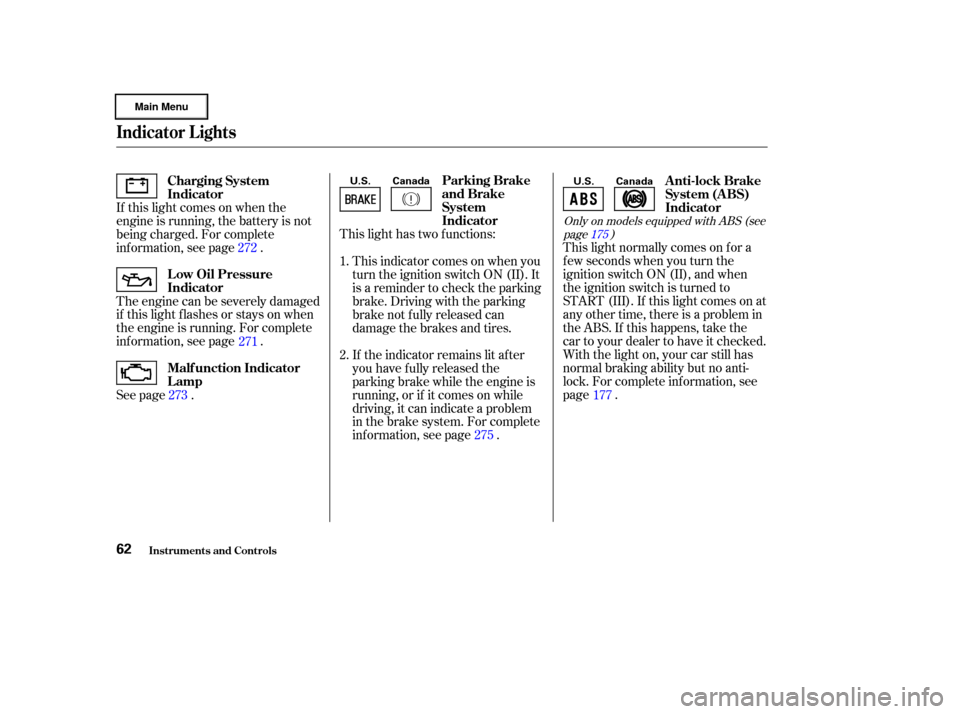
This light has two f unctions:This light normally comes on f or a
f ew seconds when you turn the
ignition switch ON (II), and when
the ignition switch is turned to
START (III). If this light comes on at
any other time, there is a problem in
theABS.If thishappens,takethe
cartoyourdealertohaveitchecked.
With the light on, your car still has
normal braking ability but no anti-
lock. For complete inf ormation, see
page .
If this light comes on when the
engine is running, the battery is not
being charged. For complete
inf ormation, see page .
The engine can be severely damaged
if this light f lashes or stays on when
the engine is running. For complete
inf ormation, see page .
This indicator comes on when you
turn the ignition switch ON (II). It
is a reminder to check the parking
brake. Driving with the parking
brake not f ully released can
damage the brakes and tires.
If the indicator remains lit after
you have f ully released the
parking brake while the engine is
running, or if it comes on while
driving, it can indicate a problem
in the brake system. For complete
inf ormation, see page .
See page . 1.
2.
272
271 275177
273
Only on models equipped with ABS (see
page ) 175
Parking Brake
and Brake
System
Indicator Anti-lock Brake
System (A BS)
Indicator
Charging System
Indicator
L ow Oil Pressure
Indicator
Malf unction Indicator
Lamp
Indicator L ights
Inst rument s and Cont rols62
U.S. Canada
U.S. Canada
Page 146 of 317
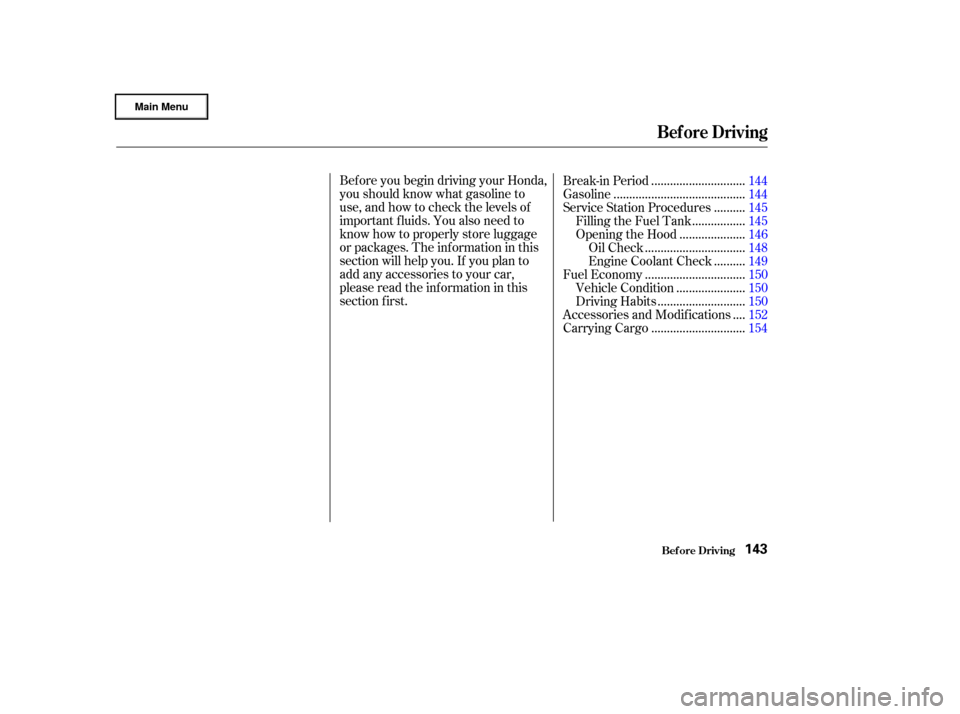
Bef ore you begin driving your Honda,
youshouldknowwhatgasolineto
use, and how to check the levels of
important f luids. You also need to
know how to properly store luggage
or packages. The inf ormation in this
section will help you. If you plan to
add any accessories to your car,
please read the inf ormation in this
section f irst..............................
Break-in Period .144
.........................................
Gasoline .144
.........
Service Station Procedures . 145
................
Filling the Fuel Tank . 145
....................
Opening the Hood .146
...............................
Oil Check .148
.........
Engine Coolant Check . 149
...............................
Fuel Economy .150
.....................
Vehicle Condition .150
...........................
Driving Habits .150
...
Accessories and Modif ications . 152
.............................
Carrying Cargo .154
Bef ore Driving
Bef ore Driving143
Page 147 of 317

During this period:Avoid full-throttle starts and rapid
acceleration.
Avoidhardbraking.Newbrakes
need to be broken-in by moderate
use f or the f irst 200 miles (300
km). Your Honda is designed to operate
on unleaded gasoline with a pump
octane number of 86 or higher. Use
of a lower octane gasoline can cause
a persistent, heavy metallic rapping
noise in the engine that can lead to
mechanical damage.
We recommend gasolines containing
detergent additives that help prevent
f uel system and engine deposits.
In Canada, some gasolines contain
an octane-enhancing additive called
MMT. If you use such gasolines,
your emission control system
perf ormance may deteriorate and
the Malf unction Indicator Lamp on
your instrument panel may turn on.
If this happens, contact your
authorized Honda dealer f or service.
Help assure your car’s f uture
reliability and perf ormance by paying
extra attention to how you drive
during the f irst 600 miles (1,000 km).
Using gasoline containing lead will
damage your car’s emissions
controls. This contributes to air
pollution.
Youshouldfollowthesesamere-
commendations with an overhauled
or exchanged engine, or when the
brakes are relined. Do not change the oil until the
recommended time or mileage
intervalshowninthemaintenance
schedule.
Break-in Period, Gasoline
Bef ore Driving
Break-in Period
Gasoline
144
Page 151 of 317
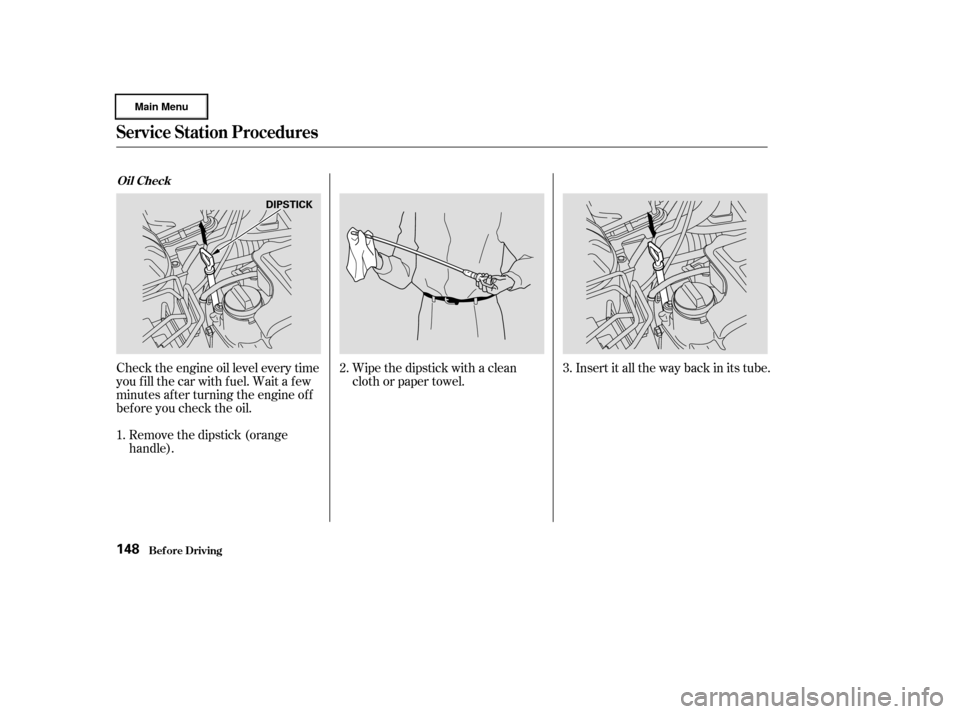
Wipe the dipstick with a clean
cloth or paper towel.Insert it all the way back in its tube.
Remove the dipstick (orange
handle).
Check the engine oil level every time
you f ill the car with f uel. Wait a f ew
minutes af ter turning the engine of f
bef ore you check the oil.
2.
3.
1.
Oil Check
Service Station Procedures
Bef ore Driving148
DIPSTICK
Page 152 of 317
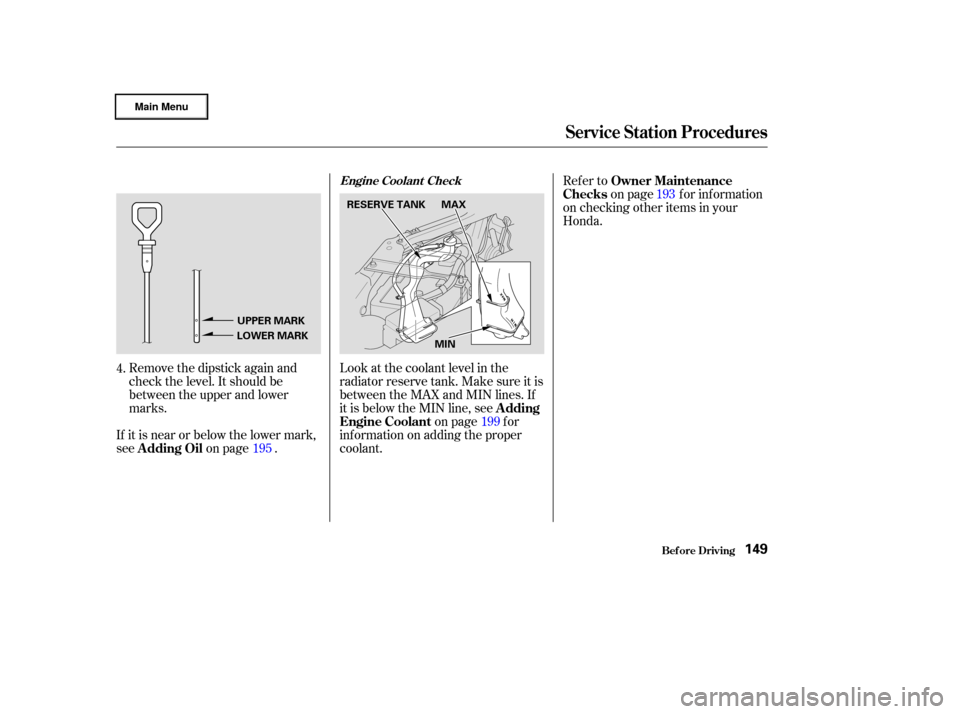
Remove the dipstick again and
check the level. It should be
between the upper and lower
marks.Look at the coolant level in the
radiator reserve tank. Make sure it is
between the MAX and MIN lines. If
it is below the MIN line, see
on page f or
inf ormation on adding the proper
coolant.
If it is near or below the lower mark,
see
on page . Refer to
on page f or inf ormation
on checking other items in your
Honda.
4. 195 199193
A dding
Engine Coolant
A dding Oil Owner Maintenance
Checks
Engine Coolant Check
Service Station Procedures
Bef ore Driving149
UPPER MARK
LOWER MARK RESERVE TANK MAX
MIN
Page 153 of 317

The condition of your car and your
driving habits are the two most
important things that affect the fuel
mileage you get.
Always maintain your car according
to the maintenance schedule. This
will keep it in top operating condition.
An important part of that mainte-
nance is the(see page ). For
example, an underinf lated tire
causes more ‘‘rolling resistance,’’
which uses f uel. It also wears out
f aster, so check the tire pressure at
least monthly. You can improve f uel economy by
driving moderately. Rapid acceler-
ation, abrupt cornering, and hard
braking use more f uel.
To get the best f uel mileage, drive in
the highest gear that is practical for
the speed you are driving, and
always accelerate slowly.
Engine oil also af f ects f uel economy.
The f uel ef f icient, low-viscosity
0W-20 oil recommended f or your
Civic Hybrid is f ormulated to help
the engine use less f uel. This oil is
available at your Honda dealer.
In winter, the build-up of snow on
your car’s underside adds weight and
rolling resistance. Frequent cleaning
helps your f uel mileage and reduces
the chance of corrosion.
You may f ind that your Civic Hybrid’s
unique combination of an engine and
an electric motor has driving
characteristics that are somewhat
dif f erent f rom what you are used to.
Shif t Up and Shif t Down indicators
(5-speed manual transmission only)
on the instrument panel show when
to shif t to a higher or lower gear. By
shifting as soon as the indicator
comes on, you will keep the engine
operating in its most economical
range.
193
Vehicle Condition
Owner Maintenance
Checks Driving Habits
Bef ore Driving
Fuel Economy
150
Page 184 of 317
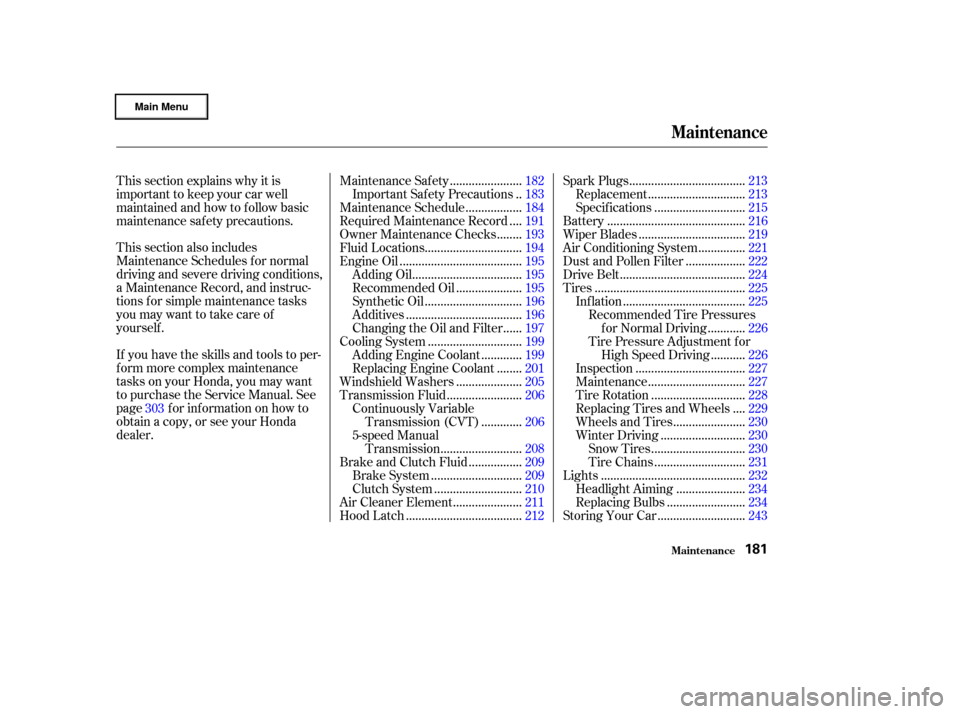
This section also includes
Maintenance Schedules f or normal
driving and severe driving conditions,
a Maintenance Record, and instruc-
tions f or simple maintenance tasks
you may want to take care of
yourself .
If you have the skills and tools to per-
f orm more complex maintenance
tasks on your Honda, you may want
to purchase the Service Manual. See
page f or inf ormation on how to
obtain a copy, or see your Honda
dealer. This section explains why it is
important to keep your car well
maintained and how to f ollow basic
maintenance saf ety precautions.......................
Maintenance Saf ety .182
.
Important Safety Precautions . 183
.................
Maintenance Schedule . 184
...
Required Maintenance Record . 191
.......
Owner Maintenance Checks . 193
..............................
Fluid Locations .194
......................................
Engine Oil .195
..................................
Adding Oil .195
....................
Recommended Oil .195
..............................
Synthetic Oil .196
....................................
Additives .196
.....
Changing the Oil and Filter . 197
.............................
Cooling System .199
............
Adding Engine Coolant . 199
.......
Replacing Engine Coolant . 201
....................
Windshield Washers .205
.......................
Transmission Fluid .206
Continuously Variable ............
Transmission (CVT) . 206
5-speed Manual .........................
Transmission .208
................
Brake and Clutch Fluid . 209
............................
Brake System .209
...........................
Clutch System .210
.....................
Air Cleaner Element .211
....................................
Hood Latch .212 ....................................
Spark Plugs .213
..............................
Replacement .213
............................
Specif ications .215
...........................................
Battery .216
.................................
Wiper Blades .219
..............
Air Conditioning System . 221
..................
Dust and Pollen Filter . 222
.......................................
Drive Belt .224
...............................................
Tires .225
......................................
Inf lation .225
Recommended Tire Pressures ...........
f or Normal Driving . 226
Tire Pressure Adjustment f or ..........
High Speed Driving . 226
..................................
Inspection .227
..............................
Maintenance .227
.............................
Tire Rotation .228
...
Replacing Tires and Wheels . 229
......................
Wheels and Tires .230
..........................
Winter Driving .230
.............................
Snow Tires .230
............................
Tire Chains .231
.............................................
Lights .232
.....................
Headlight Aiming .234
........................
Replacing Bulbs .234
...........................
Storing Your Car .243
303
Maintenance
Maint enance181